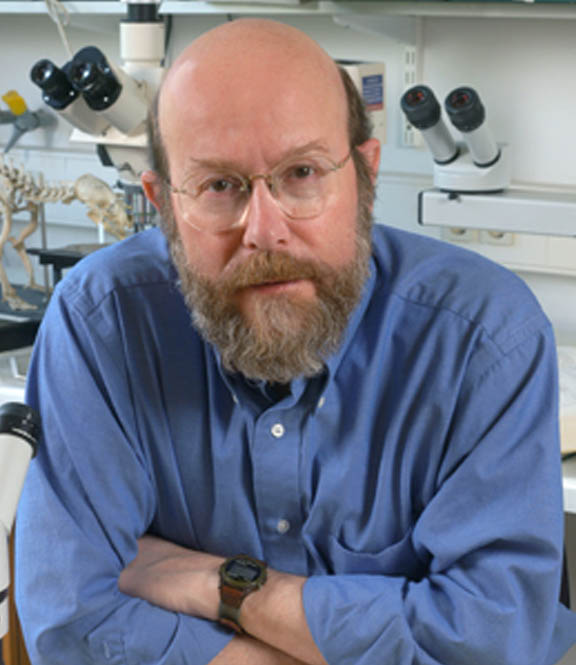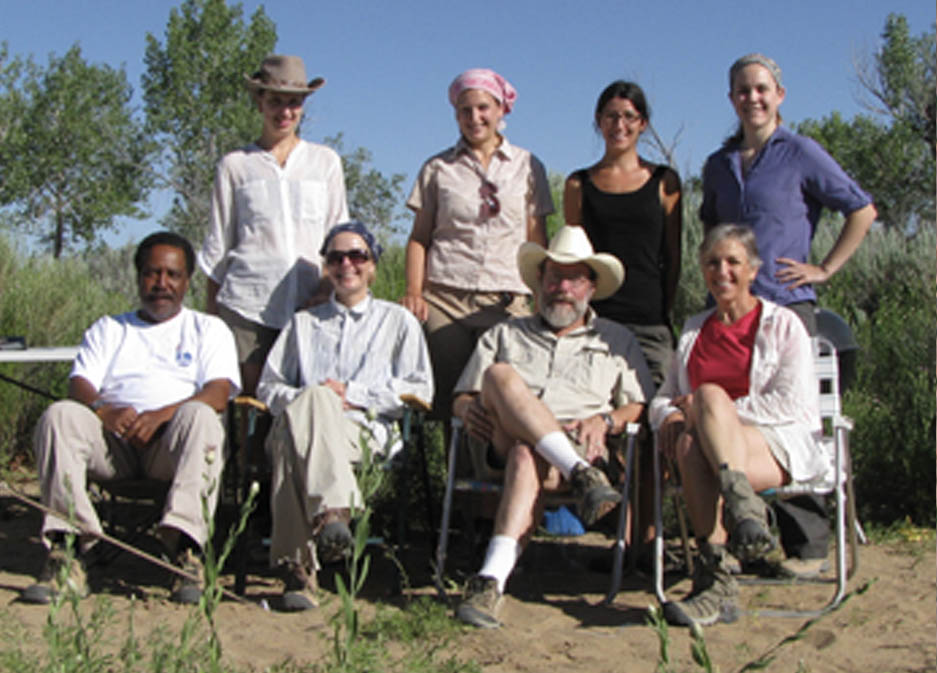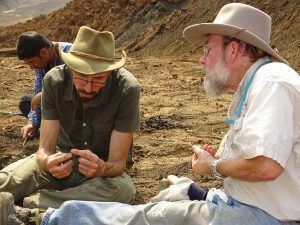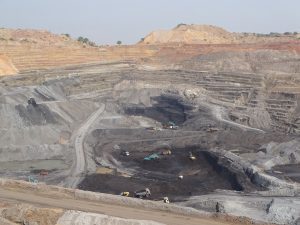Kenneth D. Rose, PhD

Education
- Ph.D. Geological Sciences: Vertebrate Paleontology, University of Michigan, 1979
- M.A. Geological Sciences, Harvard, 1974
- B.S. Geology & Geophysics: Paleobiology, Yale, 1972
Research Focuses
- Functional anatomy and evolution of early Cenozoic mammals
- Patterns of evolution at the species level
- Origins of the mammalian orders
- Faunal succession and diversity
Fieldwork

July 2011, Wyoming Field Crew (L-R, standing): Katrina Jones (FAE grad student), Leonie Schwermann (University of Bonn grad student), Simone Hoffmann (Stony Brook grad student), Heather Ahrens (FAE grad student). (L-R, seated): George Junne, Amy Chew (Western University; FAE alum), Ken Rose, Jennie Rose.
Bighorn Basin, Wyoming
The Bighorn Basin of northern Wyoming is a geologist’s paradise, with fossil-bearing sediments of nearly all ages from the Cambrian to the Oligocene. Older sediments are found along the margins of the basin and in the beautiful mountains that flank the basin (the Bighorns, Pryors, Beartooths, and Absarokas). Particularly important are the extensive exposures of Paleocene and Eocene age that cover the center of the basin, which are among the most fossiliferous continental beds of this age in the world.
Read More...
For more than 40 years we have conducted annual field work during the summer in the seemingly inexhaustible early Eocene Willwood Formation in the southern Bighorn Basin (for many years in association with Tom Bown of the USGS, and now with FAE alumna Amy Chew of Brown University) . During that time we have established more than 1200 fossil localities from throughout the 700 meter-thick section that spans almost 3 million years(about 55.5 to 52.7 my ago). Our collection of more than 50,000 fossil mammals and other vertebrate fossils is catalogued at the Smithsonian Natural History Museum and the Denver Museum of Nature and Science, though much of it is housed in the Center for FAE to facilitate study. Included are about 200 species of fossil mammals, including some of the largest available samples of the earliest primates, ungulates, carnivores, and rodents.
Research focuses on several aspects of these fossils: comparative and functional anatomy, tempo and mode of evolution, systematics and relationships, origins of mammalian orders, and faunal composition and turnover, especially as it relates to climate change in the past . Since many early Eocene mammals were long known only or primarily from their teeth, special effort has been directed toward finding and restoring their postcranial skeletons. Study of postcranial anatomy provides clues to locomotor and associated behaviors, relationships, and paleoecology. We have collected hundreds of partial skeletons, including the oldest known skeletons of primates, artiodactyls, and carnivores. The stratigraphic density and richness of our samples makes them particularly important for addressing questions of evolutionary patterns, rates, and processes. Our research on evolving lineages of mammals has adduced evidence that many groups evolved gradually through the early Eocene in the Bighorn Basin. Amy Chew’s 2005 dissertation analyzed the stratigraphic distribution of mammal species in our section and statistically demonstrated the existence of two episodes of faunal turnover during the early Eocene. Recently we completed a decade-long study of the faunal composition during the earliest Eocene (Wa-0) Paleocene-Eocene Thermal Maximum, immediately following the major turnover event at the Paleocene-Eocene boundary. Current efforts are concentrating on the relationship between climate change and faunal change at the biohorizons (the other episodes of faunal turnover) and during the latest biozone of the early Eocene. This has been a particular focus of the research of Dr. Amy Chew. Some pertinent publications resulting from our Bighorn Basin research are cited elsewhere on this webpage.
Although we work hard during the week, often in temperatures that reach or exceed 120° in the sun (there is very little shade!), there’s always time to relax around the campfire in the evening; and there are many opportunities for recreation on days off, including visiting museums in Worland, Cody or Thermopolis, hiking or relaxing in the mountains, or whitewater rafting through the Wind River Canyon. Yellowstone National Park is less than 3 hours away. Our Bighorn Basin research has been supported primarily by NSF and the National Geographic Society. See “Selected Publications” elsewhere on this page for some of our research on Wildwood fossils.

Western India
Little is known of the early Cenozoic land mammal fauna of India, and until recently, nothing had been found from prior to the middle Eocene on the Holarctic continents. Because India has been suggested as a possible source area of some of the groups that first appear in the early Eocene, it is critical to find evidence of Paleocene and early Eocene mammals there.
Read More...
With that objective in mind, we began a collaboration in 2001 with Prof. Ashok Sahni (Panjab University, Chandigarh) and Prof. Rajendra Rana (Garhwal University, Srinagar) to explore continental sediments, especially lignites, in western India for land mammals. Work focused initially on western Rajasthan, and later on lignite mines in Gujarat. Drs. Thierry Smith, Annelise Folie, Pieter Missiaen, and Floreal Sole of the Royal Belgian Institute of Natural Sciences, Brussels, and Dr. Kishor Kumar of the Wadia Institute of Himalayan Geology, Dehradun, have since joined our research team. Our multinational team, including graduate students/postdocs from FAE, the Royal Belgian Institute, and Garhwal University, worked at the Vastan Mine from 2004, to 2012, and at Mangrol and Tadkeshwar mines from 2013-2020 . Our efforts have resulted in discovery of diverse assemblages of early Eocene fishes, sharks, frogs, lizards, snakes, birds, and mammals-the first early Eocene land mammals from India. Among more than 35 mammalian species recovered so far are the oldest known lagomorph and the oldest bats known from Asia, as well as primitive insectivores, primates, artiodactyls, a perissodactyl, and the stem group from which perissodactyls likely evolved (see references below). The work has been funded by the National Geographic Society and the Leakey Foundation.


Resulting Publications
Zack, S., K.D. Rose, L.T. Holbrook, K. Kumar, R.S. Rana, and T. Smith. 2021. An enigmatic new ungulate-like mammal from the early Eocene of India. Papers in Palaeontology, 7(1):497-520. doi: 10.1002/spp2.1288
Zaher, H., A. Folie, A.B. Quadros, R.S. Rana, K. Kumar, K.D. Rose, M. Fahmy, and T. Smith. 2021. Additional vertebral material of Thaumastophis (Serpentes: Caenophidia) from the early Eocene of India provides new insights on the early diversification of colubroidean snakes. Geobios 66-67: 35-43.
Rose, K. D., L.T. Holbrook, K. Kishor, R.S. Rana, H.E. Ahrens, R.H. Dunn, A. Folie, K.E. Jones, and T. Smith. 2020. Anatomy, relationships, and paleobiology of Cambaytherium (Mammalia, Perissodactylamorpha, Anthracobunia) from the lower Eocene of western India. Society of Vertebrate Paleontology Memoir 20. Journal of Vertebrate Paleontology 39 (6, Supplement): 1-147. DOI: 10.1080/02724634.2020.1761370
Solé, F., E. De Bast, H. Legendre, R.S. Rana, K. Kumar, K.D. Rose, and T. Smith. 2020. New specimens of Frugivastodon (Mammalia: Apatotheria) from the early Eocene of India confirm its apatemyid status and elucidate dispersal of Apatemyidae; pp. 279-304 in: Biological Consequences of Plate Tectonics: New Perspectives on Post-Gondwanaland Break-up—A Tribute to Ashok Sahni (G. V. Prasad and R. Patnaik, eds.),Vertebrate Paleobiology and Paleoanthropology Series, Springer. https://doi.org/10.1007/978-3-030-49753-8_12
Koenigswald, W.v., K.D. Rose, L.T. Holbrook, K. Kumar, R.S. Rana, and T. Smith. 2018. Mastication and enamel structure in Cambaytherium, a perissodactyl-like ungulate from the early Eocene of India. PalZ (Paläontologische Zeitschrift) 92(4): 671-680
Rose, K.D., R.H. Dunn, K. Kumar, J.M.G. Perry, K. Prufrock, R.S. Rana, and T. Smith. 2018. New fossils from Tadkeshwar Mine (Gujarat, India) increase primate diversity from the early Eocene Cambay Shale. J. Human Evol. 122: 93-107.
Dunn, R.H., K.D. Rose, R.S. Rana, K. Kumar, A. Sahni, T. Smith. 2016. New euprimate postcrania from the early Eocene of Gujarat, India, and the strepsirrhine-haplorhine divergence. J. Human Evol. 99: 25-51.
Smith, T., K. Kumar, R.S. Rana, A. Folie, F. Solé, C. Noiret, T. Steeman, A. Sahni, and K.D. Rose. 2016. New early Eocene vertebrate assemblage from western India reveals a mixed fauna of European and Gondwanan affinities. Geoscience Frontiers 7: 969-1001.
Rana, R.S., K. Kumar, S.P. Zack, F. Solé, K.D. Rose, P. Missiaen, L. Singh, A. Sahni, and T. Smith. 2015. Craniodental and postcranial morphology of Indohyaenodon raoi from the early Eocene of India, and its implications for ecology, phylogeny, and biogeography of hyaenodontid mammals. J. Vert. Paleont. 35(5), e965308
Smith, T., F. Solé, P. Missiaen, R.S. Rana, K. Kumar, A. Sahni, and K.D. Rose. 2015. First early Eocene tapiroid from India and its implication for the paleobiogeographic origin of perissodactyls. Palaeovertebrata 39 (2)-e5
Rose, K.D., L.T. Holbrook, R.S. Rana, K. Kumar, K.E. Jones, H.E. Ahrens, P. Missiaen, A. Sahni, and T. Smith. 2014. Early Eocene fossils suggest that the mammalian order Perissodactyla originated in India. Nature Communications 5:5570 doi: 10.1038/ncomms6570
Rose, K.D., K. Kumar, R.S. Rana, A. Sahni, and T. Smith. 2013. New hypsodont tillodont (Mammalia: Tillodontia) from the early Eocene of India. J. Paleontology 87: 842-853.
Folie, A., R.S. Rana, K.D. Rose, A. Sahni, K. Kumar, L. Singh, and T. Smith 2013. Early Eocene frogs from Vastan Lignite Mine, Gujarat, India. Acta Palaeont. Polonica. 58 (3): 511-524. (view here)
Mayr, G., R.S. Rana, K.D. Rose, A. Sahni, K. Kumar, and T. Smith. 2013. New specimens of the early Eocene bird Vastanavis and the interrelationships of stem group Psittaciformes. Paleontological Journal 47(11): 1-7.
Rana, R.S., M. Augé, A. Folie, K.D. Rose, K. Kumar, L. Singh, A. Sahni, and T. Smith. 2013. High diversity of acrodontan lizards in the Early Eocene Vastan Lignite Mine of India. Geologica Belgica 16/4: 290-301.
Mayr, G., R.S. Rana, K.D. Rose, A. Sahni, K. Kumar, L. Singh, and T. Smith. 2010. Quercypsitta-like birds from the early Eocene of India (Aves, ?Psittaciformes). J. Vert. Paleontol. 30: 467-478.
Kumar, K., K.D. Rose, R.S. Rana, L. Singh, T. Smith, and A. Sahni. 2010. Early Eocene artiodactyls (Mammalia) from western India. J. Vert. Paleontol. 30(4): 1245-1274.
Rose, K.D., R.S. Rana, A. Sahni, K. Kumar, P. Missiaen, L. Singh, and T. Smith. 2009. Early Eocene Primates from Gujarat, India. J. Human Evol. 56: 366-404.
Rose, K.D., R.S. Rana, A. Sahni, K. Kumar, L. Singh, and T. Smith. 2009. First tillodont from India: Additional evidence for an early Eocene faunal connection between Europe and India? Acta Palaeont. Polonica 54(2): 351-355.
Rage, J.-C., A. Folie, R.S. Rana, H. Singh, K.D. Rose, and T. Smith. 2008. A diverse snake fauna from the early Eocene of Vastan Lignite Mine, Gujarat, India. Acta Palaeontologica Polonica 53: 391-403.
Rana, R.S., K. Kumar, G. Escarguel, A. Sahni, K.D. Rose, T. Smith, H. Singh, and L. Singh. 2008. An ailuravine rodent from the lower Eocene Cambay Formation at Vastan, western India, and its palaeobiogeographic implications. Acta Palaeontol. Polonica 53(1): 1-14.
Rose, K.D., V.B. DeLeon, P. Missiaen, R.S. Rana, A. Sahni, L. Singh, and T. Smith. 2008. Early Eocene lagomorph (Mammalia) from western India and the early diversification of Lagomorpha. Proc. Royal Soc. London B 275: 1203-1208.
Rose, K.D., R.S. Rana, A. Sahni, and T. Smith. 2007. A new adapoid primate from the early Eocene of India. Contrib. Univ. Michigan Museum Paleont. 31(14): 379-385.
Smith, T., R.S. Rana, P. Missiaen, K.D. Rose, A. Sahni, H. Singh, L. Singh. 2007. Highest diversity of earliest bats in the Early Eocene of India. Naturwissenschaften 94(12): 1003-1009.
Rose, K.D., T. Smith, R.S. Rana, A. Sahni, H. Singh, P. Missiaen, and A. Folie. 2006. Early Eocene (Ypresian) continental vertebrate assemblage from India, with description of a new anthracobunid (Mammalia, Tethytheria). J. Vert. Paleont. 26: 219-225.
Sahni, A., P.K. Saraswati, R.S. Rana, K. Kumar, H. Singh, H. Alimohammadian, N. Sahni, K.D. Rose, L. Singh, and T. Smith. 2006. Temporal constraints and depositional palaeoenvironments of the Vastan Lignite Sequence, Gujarat: analogy for the Cambay Shale hydrocarbon source rock. Indian J. Petroleum Geol. 15(1): 1-20.
Rana, R.S., K. Kumar, R.S. Loyal, A. Sahni, K.D. Rose, J. Mussell, H. Singh, and S.K. Kulshreshtha. 2006. Selachians from the early Eocene Kapurdi Formation (Fuller’s Earth), Barmer District, Rajasthan, India. J. Geol. Soc. India 67: 509-522.
Rana, R.S., H. Singh, A. Sahni, K.D. Rose, and P.K. Saraswati. 2005. Early Eocene chiropterans from a new mammalian assemblage (Vastan Lignite Mine, Gujarat, Western Peninsular Margin): oldest known bats from Asia. J. Palaeontological Soc. India 50(1): 93-100.
Rana, R.S., K. Kumar, H. Singh, and K.D. Rose. 2005. Lower vertebrates from the Late Palaeocene-Earliest Eocene Akli Formation, Giral Lignite Mine, Barmer District, western India. Current Science 89: 1606-1613.
Sahni, A., R.S. Rana, R.S. Loyal, P.K. Saraswati, S.K. Mathur, K.D. Rose, S.K.M. Tripathi, and R. Garg. 2004. Western Margin Palaeocene-lower Eocene lignites: biostratigraphic and palaeoecological constraints. Proceedings 2nd Conference, Association Petroleum Geologists (Khajuraho, India), ONGC, Tech.Sess. III: 1-22.
Selected Publications
Rose, K.D., J.M.G. Perry, K.A. Prufrock, and R.E. Weems. 2021. Early Eocene omomyid from the Nanjemoy Formation of Virginia: first fossil primate from the Atlantic Coastal Plain. Journal of Vertebrate Paleontology 41(1): e1923340. DOI: 10.1080/02724634.2021.1923340.
Silcox, M.T., K.R. Selig, T.M. Bown, A. E. Chew, and K.D. Rose. 2021. Cladogenesis and replacement in the fossil record of Microsyopidae (?Primates) from the southern Bighorn Basin, Wyoming. Biology Letters 17(2): 20200824.
Prufrock, K.A., C.B. Ruff, and K.D. Rose. 2021. Locomotor behavior and body mass of Paramys delicatus (Ischyromyidae, Rodentia) and commentary on other early North American paramyines. Journal of Mammalian Evolution 28: 435-456. https://doi.org/10.1007/s10914-020-09523-8
Rose, K.D., L.T. Holbrook, K. Kishor, R.S. Rana, H.E. Ahrens, R.H. Dunn, A. Folie, K.E. Jones, and T. Smith. 2020. Anatomy, relationships, and paleobiology of Cambaytherium (Mammalia, Perissodactylamorpha, Anthracobunia) from the lower Eocene of western India. Society of Vertebrate Paleontology Memoir 20. Journal of Vertebrate Paleontology 39 (6, Supplement): 1-147. DOI: 10.1080/02724634.2020.1761370
Gaudin, T.J., J.R. Wible, K.D. Rose, R.J. Emry, and M. Spaulding. 2019. Skeletal anatomy of the basicranium and auditory region in the metacheiromyid palaeanodont Metacheiromys (Mammalia, Pholidotamorpha) based on high-resolution CT scans. Fossil Imprint 75(3-4): 484-503.
Rose, K.D., L.T. Holbrook, and W.P. Luckett. 2018. Deciduous premolars of Eocene Equidae and their phylogenetic significance. Historical Biology 30(1-2): 89-118.
Ruf, I., V. Volpato, K.D. Rose, G. Billet, C. de Muizon, and T. Lehmann. (2016) Digital reconstruction of the inner ear of Leptictidium auderiense (Leptictida, Mammalia) reveals new insight into leptictidan locomotion. Paläontologische Zeitschrift 90(1): 153-171. DOI: (View from website)
Dunn, R.H., K.D. Rose, R.S. Rana, K. Kumar, A. Sahni, T. Smith. (2016) New euprimate postcrania from the early Eocene of Gujarat, India, and the strepsirrhine-haplorhine divergence. J. Human Evol. 99: 25-51. DOI: (view from website)
Smith, T., K. Kumar, R.S. Rana, A. Folie, F. Solé, C. Noiret, T. Steeman, A. Sahni, and K.D. Rose. (2016) New early Eocene vertebrate assemblage from western India reveals a mixed fauna of European and Gondwanan affinities. Geoscience Frontiers 7: 969-1001.
Zack, S.P., and K.D. Rose. (2015) The postcranial skeleton of Galecyon: evidence for morphological and locomotor diversity in early Hyaenodontidae (Mammalia, Hyaenodontida). Journal of Vertebrate Paleontology 35(6) e1001492 (25 pages). DOI: (view from website); cover.
Dunn, R.H., and K.D. Rose. (2015) Evolution of early Eocene Palaeosinopa (Mammalia, Pantolestidae) in the Willwood Formation of the Bighorn Basin, Wyoming. Journal of Paleontology 89(4): 665-694. DOI: (view from website)
Rana, R. S., K. Kumar, S.P. Zack, F. Solé, K.D. Rose, P. Missiaen, L. Singh, A. Sahni, and T. Smith. (2015) Craniodental and postcranial morphology of Indohyaenodon raoi from the early Eocene of India, and its implications for ecology, phylogeny, and biogeography of hyaenodontid mammals. J. Vert. Paleo. 35(5), e965308 (22 pages). DOI: 10.1080/02724634.2015.965308 (view here)
Rose, K.D., L.T. Holbrook, R.S. Rana, K. Kumar, K.E. Jones, H.E. Ahrens, P. Missiaen, A. Sahni, and T. Smith. (2014) Early Eocene Fossils suggest that the mammalian order Perissodactyla originated in India. Nat. Commun. 5: 5570. (view here)
Gould, F.H.D. and K.D. Rose. (2014) Gnathic and postcranial skeleton of the largest known arctocyonid “condylarth,” Arctocyon mumak, (Mammalia, Procreodi) and ecomorphological diversity in Procreodi. J. Vert. Paleontol. 34: 1180-1202.
Jones, K.E., K.D. Rose, and J. Perry. (2014) Body size and premolar evolution in the early–middle Eocene euprimates of Wyoming. Am. J. Phys. Anthropol. 153: 15-28.
Rose, K.D., R.H. Dunn, and L. Grande. (2014) A new pantolestid skeleton from the early Eocene Fossil Butte Member, Green River Formation (Wyoming), and skeletal ontogeny in Pantolestidae (Mammalia, Pantolesta). J. Vert. Paleontol. 34(4): 932-940.
Rose, K.D., G. Storch, and K. Krohmann. (2013) Small-mammal postcrania from the middle Paleocene of Walbeck, Germany. Paläontologische Zeitschrift. (view here)
Rose, K.D., K. Kumar, R.S. Rana, A. Sahni, and T. Smith. (2013) New hypsodont tillodont (Mammalia: Tillodontia) from the early Eocene of India. J. Paleontol. 87: 842-853.
Kalthoff, D.C., K.D. Rose, and W. v. Koenigswald. (2011) Dental microstructure in Palaeanodon and Tubulodon (Palaeanodonta) and bioerosional tunneling as a widespread phenomenon in fossil mammal teeth. J. Vert. Paleontol. 31(6): 1303-1313. (view from JVP page)
Koenigswald, W. v., L.T. Holbrook, and K.D. Rose. (2011) Diversity and evolution of Hunter-Schreger band configuration in tooth enamel of perissodactyl mammals. Acta Palaeont. Polonica 56(1): 11-32. (view from BioOne page)
Rose, K.D. (2010) New marsupial from the early Eocene of Virginia. J. Paleontol. 84: 561-565. (view from BioOne page)
Kumar, K., K.D. Rose, R.S. Rana, L.Singh, T. Smith, and A. Sahni. (2010) Early Eocene artiodactyls (Mammalia) from western India. J. Vert. Paleontol. 30(4): 1245-1274.(view from JVP page)
Rose, K.D., R.S. Rana, A. Sahni, K. Kumar, P. Missiaen, L. Singh, and T. Smith. (2009) Early Eocene Primates from Gujarat, India. J. Human Evol. 56: 366-404. (view from Elsevier JHE page)
Rose, K.D., V.B. DeLeon, P. Missiaen, R.S. Rana, A. Sahni, L. Singh, and T. Smith. (2008) Early Eocene lagomorph (Mammalia) from western India and the early diversification of Lagomorpha. Proc. Royal Soc. London B 275: 1203-1208. (view from Royal Society Publishing site)
Silcox, M.T., K.D. Rose, and T.M. Bown. (2008) Early Eocene Paromomyidae (Mammalia, Primates) from the southern Bighorn Basin, Wyoming: systematics and evolution. J. Paleontol. 82: 1074-1113. (view from Paleontological Society page)
Smith, T., R.S. Rana, P. Missiaen, K.D. Rose, A. Sahni, H. Singh, L. Singh. (2007) Highest diversity of earliest bats in the Early Eocene of India. Naturwissenschaften 94(12): 1003-1009
Rose, K.D., and W. von Koenigswald. (2007) The marmot-sized paramyid rodent Notoparamys costilloi from the early Eocene of Wyoming, with comments on dental variation and occlusion in paramyids. Bull. Carnegie Mus. Nat. Hist. 39:111-125.
Rose, K.D. (2006) The Beginning of the Age of Mammals. Baltimore: Johns Hopkins Univ. Press. 428 pp.
Rose, K.D. (2006) The postcranial skeleton of early Oligocene Leptictis (Mammalia: Leptictida), with a preliminary comparison to Leptictidium from the middle Eocene of Messel. Palaeontographica Abteilung A 278: 37-56.
Smith, T., K.D. Rose, and P. D. Gingerich. (2006) Rapid Asia-Europe-North America geographic dispersal of earliest Eocene primate Teilhardina during the Paleocene-Eocene Thermal Maximum. Proc. Nat. Acad. Sci. USA 103: 11223-11227. (view from PNAS site)
Rose, K.D., and W.v. Koenigswald. (2005) An exceptionally complete skeleton of Palaeosinopa (Mammalia, Cimolesta, Pantolestidae) from the Green River Formation, and other postcranial elements of the Pantolestidae from the Eocene of Wyoming. Palaeontographica Abteilung A 273: 55-96. (visit Palaeontographica site)
Zack, S., T.A. Penkrot, J.I. Bloch, and K.D. Rose. (2005) Affinities of ‘hyopsodontids’ to elephant shrews and a Holarctic origin of Afrotheria. Nature 434: 497-501. (view from Nature site)
News
Upcoming Event September 23, 2025
Welcome Sandra Grant!
It is our immense pleasure to announce that Sandra Grant will be joining the FAE staff as our new Administrative Manager on March 17, 2025. Sandra has previous experience at Johns Hopkins University working as an Administrative Manager in the Modern Languages and...
HPU Graduate Anatomy Teaching Fellow 2025
High Point University is advertising five Graduate Anatomy Teaching Fellow positions for Summer 2025. PhD Candidates near the end of their training (soon to be on the job market) are their target but they encourage any student considering an anatomy career to apply....
